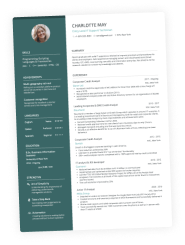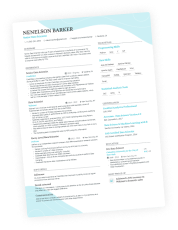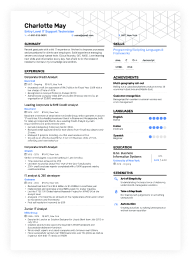Part-time jobs don’t always get the credit they deserve. You might be worried that adding “part-time” to your resume will make you look less committed or less qualified. The truth? Recruiters care less about whether a role was full-time or part-time and far more about what you achieved in it.
Key takeaways
- Format part-time jobs just like full-time ones—title, company, location, and dates.
- Make the scope clear by adding “(Part-Time)” or weekly hours so hiring managers understand the role immediately.
- Reframe routine tasks into impact-driven achievements that show what you contributed.
- Use part-time roles to demonstrate practical skills like conflict resolution, cash handling, or scheduling—skills employers value across industries.
- Group short or unrelated part-time jobs together to keep your resume concise and focused.
- Treat part-time experience as proof of reliability, adaptability, and career growth—it tells a stronger story than leaving gaps.
Upload your resume to Enhancv’s AI-powered checker and see instantly how recruiters will view it—plus get tailored tips to make every job count.
Is your resume good enough?
Drop your resume here or choose a file. PDF & DOCX only. Max 2MB file size.
Should you put part-time jobs on a resume?
Yes, part-time jobs absolutely belong on your resume. They show you’ve been active, responsible, and developing skills that apply to full-time roles.
Whether you worked weekends in retail, balanced classes with a campus job, or took on side shifts during a transition, each of those experiences adds credibility. What matters most is how you present them: focus on achievements, impact, and the skills that connect to your next role.
How to format part-time jobs on a resume
Think of formatting your part-time experience the same way you’d format a full-time role—it deserves the same treatment. Employers want to see where you worked, what you did, and the impact you made. The only difference is making it clear that the role wasn’t full-time.
Here’s how to do it:
- Follow the standard structure: Job title, company, location, and dates of employment.
- Clarify that it was part-time: Add “(Part-Time)” after your job title or mention average weekly hours in a short line beneath it.
- List multiple part-time roles smartly:Separate them if they’re relevant, and group shorter stints in the same field under one heading to keep things concise.
This approach works whether you’re a student balancing classes, a career changer building new skills, or someone filling a gap between full-time roles. In every case, part-time experience demonstrates reliability and growth.
And remember—even a few hours a week in a part-time role is better than leaving a blank space on your resume. It shows employers you stayed active, learned on the job, and kept buildingvaluable skills.
Here’s an example of a well-formatted entry created with our resume builder:
- •Assisted an average of 60+ customers per shift, improving customer satisfaction scores by 15%.
- •Trained 4 new hires in POS systems and store procedures, developing leadership and mentoring skills.
- •Balanced cash drawers with 100% accuracy over 18 months, demonstrating reliability and attention to detail.
Turning part-time work into transferable skills
The biggest mistake candidates make with part-time jobs isn’t listing them—it’s underselling them. Every role, no matter how many hours you work, helps you build skills that carry into future careers. Recruiters want to see those skills, not just a list of shift duties.
Skills part-time jobs add to your resume
- Cash handling and accuracy: Managing money, tracking sales, and ensuring error-free transactions.
- Conflict resolution: Calming upset customers, solving issues quickly, and maintaining professionalism under pressure.
- Upselling and persuasion: Recommending products or services that boosted sales and customer satisfaction.
- Scheduling and logistics: Coordinating shifts, balancing priorities, and keeping operations running smoothly.
- Process improvement: Spotting inefficiencies and suggesting ways to save time or reduce errors.
- Tech skills: Confidently using POS systems, scheduling apps, or workplace software.
Once you’ve identified those skills, make sure they shine in your bullet points.
Instead of writing task-based bullets like:
“Worked the cash register at a retail store.”
Transform them into achievement-focused statements like:
“Processed 50+ transactions per shift with 100% accuracy while resolving customer issues, building trust, and improving satisfaction scores.”
That shift in language turns part-time work from filler into a proof point of professional growth. Use Enhancv’s Bullet Point Generator if you need some help with this.
Common questions about listing part-time jobs
How do I show a promotion from part-time to full-time?
Note the progression briefly within the same entry—for example, mention that you were promoted from part-time to full-time or took on additional responsibilities. It’s an easy way to show growth and reliability.
Should I list freelance, gig, or platform work (like Uber, Fiverr, or TaskRabbit)?
Yes, if it’s relevant or shows transferable skills such as customer service, time management, or self-motivation. Present it like any other role with clear dates and a few results-oriented bullet points.
Do I need to explain why I worked part-time?
Only if it adds useful context—like balancing school, caregiving, or relocation. Keep it short and factual, or mention it briefly in your cover letter instead.
What if I worked part-time while studying?
That experience matters. It proves strong time management, discipline, and initiative—qualities every employer values. Simply make it clear in your education or experience section.
How do I handle several short part-time jobs or gigs?
Group similar roles under one heading (e.g., “Retail Experience” or “Freelance Projects”) and summarize shared responsibilities or achievements. This keeps your resume focused and easy to read.
Conclusion
Part-time jobs aren’t a footnote on your resume—they’re real experience. When you present them with clarity and connect them to valuable skills, they strengthen your career story and show employers you can adapt, contribute, and grow. Every role adds value—what matters is how you tell the story.
Make one that's truly you.



